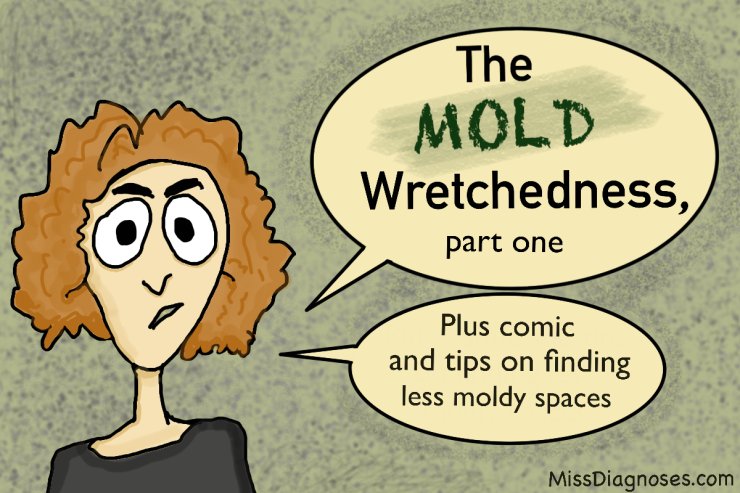In October 2020, my housemate and I discovered we had stachybotrys (toxic black mold) and other evil molds in our apartment. We realized we had to move—we knew the Extremely Cheap and Annoying Landlord would not do a good job remediating, and I already had Lyme disease and mast cell activation syndrome (MCAS).
We went on a mad apartment search. We looked at about 40 apartments, sometimes checking out two or three per day. We were eight months into the pandemic and we were trying to sniff out moldy odors while double-masked. Realtors who had prepared themselves to show off the view were puzzled to find us with our heads under the sinks, peering at the pipes with flashlights. There really weren’t any completely non-moldy spaces—even an apartment that was five months old had a tiny bit of mold. (We would have taken it, but it hadn’t offgassed and had intense, headachy, Toxic-New-Construction smell.)
I used to think ”nice” new buildings couldn’t be moldy, but water damage can happen anywhere, even in “luxury” buildings and new McMansions (a lot of McMansions are built in a hurry, and builders cut corners on construction). Most older buildings have some mold, but in the 1970s builders started to use drywall, which mold loves to eat, so that affects new buildings. The key is to find a place that doesn’t have a ton of mold and doesn’t have the top neurotoxic molds.

A health coach who specialized in mold told us we could use the ERMI or HERTSMI tests as a starting point to screen potential apartments. The ERMI tests for 36 molds and the HERTSMI tests for the top five toxic molds. Both tests make you collect dust from apartments on Swiffer cloths and send the cloths to a lab. The realtors tended to be less than understanding when they saw us wandering around Swiffer-wiping, so I usually would distract the agent while my housemate ran into the bedroom to wipe the closet (closet rods and shelves are a good source of dust). Testing a lot of places is expensive, so the coach taught us how to do a visual inspection to decide whether an apartment was test-worthy.
This list is by no means complete, but it’s a good starting point if you’re ever in this situation (I REALLY hope you aren’t)!
Tips for Visually Inspecting Apartments for Water Damage and Mold
- Windows: Leaky windows are one of the biggest problems for mold growth. Look for lots of condensation on the windows (a sign of poor ventilation), stains underneath the windows on the inside and the outside, bubbles in the paint around the windows, and of course actual mold (green, white, pink, or black). Check the floors around the windows and see if they are uneven, buckled, warped, or soft. Open and close the windows to check whether they seal correctly.
- Ceilings: Check for water stains, especially in the kitchen and the bathroom. We looked at a beautiful, fairly new apartment but had to rule it out because it had a gigantic circular water stain on the ceiling in the shower. Make sure to check the corners of the ceilings. Look for patchup jobs with paint and areas of the ceiling that have a different texture than the rest.
- Walls: Look for water stains on the walls and cracks or discoloration where the walls meet. If it is yellow where the walls meet and the walls are white, this is usually a bad sign. Check if the baseboards are separated from the walls.
- Cabinets: In the kitchen and the bathroom, check under the sinks for water stains, warped wood, stains, and mold growth. Touch the pipes to see if there is leakage. Check if it is wet behind the toilet.
- Showers: Check the shower stall for mold and check the wall in the room next to the shower or bathroom to see if it is wet. Check for water stains on the shower ceiling. If there is mold on grout, grout can be replaced, but mold behind the walls is a much bigger problem. Bathrooms should have either a good exhaust fan or a window. I run a dehumidifier in my bathroom now to prevent new mold growth and I squeegee the shower after I use it. I love long showers, but they create a lot of moisture.
- Vents: Check the vents—are they clean or gray? Is there a lot of dust or dirt? We looked at a four-year-old building and the vent in the bathroom was black, speckled, and there was a musty smell.
- Heating/Air–conditioning: Radiators are generally better than central air. If you have heating/air-conditioning units, check around them for buckled flooring or bubbling paint.
- Washer/Dryer: Check the washer/dryer for standing water, mold on the rubber gasket, or mold in the soap dispenser. Front loaders are notorious for getting mold on the gaskets, but you can prevent this problem by wiping the gasket dry after each wash and spraying it with an anti-mold cleaner such as EC3 spray.
- General: Check for musty smells. Ask if there have been any floods or leaks. How is the ventilation in the space? Spaces that get a lot of sun are better, as are larger constructions because they usually have better engineering.
When you find a good place, it’s super-helpful to hire a mold inspector to do a final check, especially if you have mold illness symptoms. Not all inspectors are thorough and some are expensive, but you can ask for recommendations in mold patient Facebook groups. If you live in New York, I really recommend this company.
We finally found an apartment, but my view of buildings is forever changed! I hope these tips are helpful, but I also hope you NEVER need them!
Spoonfully Yours,
Vicki




Very helpful tips . . . thank you for the comprehensive checklist. And very funny cartoon!
LikeLiked by 1 person